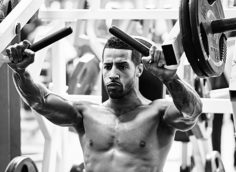Isolation exercises once reigned supreme in the old muscle magazines. The concentration curl and other specialty, machine-based exercises were all the rage in strength and muscular development.
Over time the trend began to shift to more compound, bang-for-your-buck exercises. For the most part, this is good and necessary, but there's value in isolation exercises that shouldn't be minimized.
Think of these lifts as just another tool. They're best used for a specific job. They're not the best for developing major traits like absolute strength or speed, but they have several other benefits. Let's get into those.
If you've got a distinct weakness or muscular imbalance that's hindering your results, you should attack it. Gain strength in that specific area. Isolation exercise to the rescue!
Think of the common lifter who trains chest two to three times per week and trains back less frequently and with less of a focus. This imbalance will lead to an overall weaker body and injuries down the road.
Including some isolation exercises such as banded face-pulls and band tears to target the upper back, lats, and other areas of the back is an appropriate solution. Check 'em out:
More experienced lifters who want to continue making progress may need to take an even more specialized approach with exercise selection. These lifters have paid their dues under the bar and will benefit from becoming more precise in training.
If their progress has stalled due to the inability to lock out the bar, then it's necessary to build up the triceps for the lockout strength. Using isolation exercises like press downs, extensions of various grips, and the use of specialized attachments will build up that muscle and allow it to catch up with the rest of your strength. This will lead to an overall increase in the bench press.
Here are a few triceps isolation moves that'll help you with your bench press. As we progress with lifting, the smaller, micro enhancements will be required to build upon the larger movements.
Having a solid warm-up is necessary for a productive session, but there aren't many who use isolation moves for this purpose. That's a mistake.
Choose isolation exercises specific to the muscle groups and actions required for that workout, and you'll begin activating the key muscles and increasing blood flow to the surrounding areas.
Try a pre-fatigue approach to increase muscle hypertrophy. Just choose an isolation lift that'll help you target the muscle you want to hit the most. Once you get into your workout, you'll have an even greater mind-muscle connection with those muscles when you begin the compound lifts.
Isolation work during a warm-up can also help older, banged-up lifters feel more prepared for the session since it typically takes longer to get completely warmed up. Granted, you may not be able to use as much weight on the primary lift that day, but think of it as more of a long-term investment. Unless you're a competitive weightlifter or powerlifter, the results of getting healthier will outweigh the actual weight on the bar.
A real-world application of this would be using the seated, band leg curl before any major lower body workouts:
Seated Band Leg Curl
If you do the band leg curl for high reps, it'll push a bunch of blood to the knee and surrounding areas, making the body and specific joints better prepared. The key to using this method is using light to moderate weight for more reps and focusing on the actual muscle contraction. Go after the pump.
When you're recovering from an injury or surgery, isolation exercises will become a huge piece of your rehab strategy to begin introducing the tissues to load and slowly accepting more stress.
I'm not saying to take rehab into your own hands if you're not recovering from such things, but instead, use isolation exercises to take a more proactive approach. Implement isolation exercises to help create a foundation of armor (muscle) to help keep the body as resilient as possible, especially in commonly injured areas such as the shoulders and hips.
Here are a few moves you can do to protect your shoulders and knees:
And here are some things you can do to strengthen and protect your hips:
When training to increase muscular size, the main driving factors are metabolic stress, muscular tension, and muscular damage. To achieve these requirements, we can use more advanced training methods such as drop sets and finishing sets taken to failure.
While major compound exercises play the primary role in strength and muscle building, the isolation exercises are safer and can be more effective during these finishing sets.
Exercises that require a high level of skill or technique don't work as well when going to failure or attempting to drop weight rapidly for a drop set. A pin-loaded machine will just take seconds to set up, and you don't have to worry about dropping the weight on yourself either.
Bent-Over Row Cable Row Drop Set
Seated Leg Curl Drop Set
Just like fashion, trends in fitness come and go. The giants who once graced the pages of old-school magazines preached a lot of things that we've since determined to be not quite as effective. It'd be a mistake to only use isolation movements for muscular size. But, in the right context, they can help you achieve bigger lifts.





